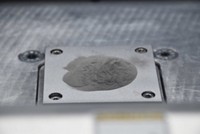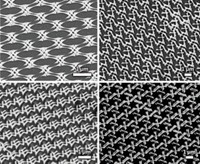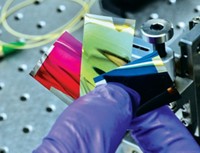Advertisement
Grab your lab coat. Let's get started
Welcome!
Welcome!
Create an account below to get 6 C&EN articles per month, receive newsletters and more - all free.
It seems this is your first time logging in online. Please enter the following information to continue.
As an ACS member you automatically get access to this site. All we need is few more details to create your reading experience.
Not you? Sign in with a different account.
Not you? Sign in with a different account.
ERROR 1
ERROR 1
ERROR 2
ERROR 2
ERROR 2
ERROR 2
ERROR 2
Password and Confirm password must match.
If you have an ACS member number, please enter it here so we can link this account to your membership. (optional)
ERROR 2
ACS values your privacy. By submitting your information, you are gaining access to C&EN and subscribing to our weekly newsletter. We use the information you provide to make your reading experience better, and we will never sell your data to third party members.
Materials
Fabrication Method Makes Smaller Magnetic Sensors For Hard Drives
Devices: A new way of producing layered metal nanostructures constructs high-performing 10-nm magnetic read heads
by Katherine Bourzac
August 3, 2012

Each generation of computer hard drives can store more data than the last. Manufacturers pack ever smaller memory cells, the magnetic structures that store data, into ever denser arrays on the drives’ disks. As the memory cells become smaller, the devices that read them must also shrink. But fabricating nanoscale read heads often creates structural defects that disrupt their function. Now researchers have developed a way to make high-performance magnetic read heads that are just 10 nm in diameter (Nano Lett., DOI: 10.1021/nl301610z).
Today’s magnetic memory uses a principle called giant magnetoresistance, in which an external magnetic field affects the electrical resistance of magnetic structures. Memory cells on a hard drive disk have their own magnetic fields, with an orientation that corresponds to their “1” or “0” state. When the read head passes above a memory cell, the cell’s field can change the orientation of the magnetic field in part of the read head. Because the electrical resistance in the head sensor depends on the orientation of this field, the drive can read out the “1s” and “0s” on its disk.
Unfortunately, when researchers make read heads smaller than 30 nm in diameter, structural defects can cause malfunctions, says Bethanie Stadler, an electrical and computer engineer at the University of Minnesota, Twin Cities.
That’s because manufacturers use an ion beam to carve out the cylindrical structures from magnetic materials consisting of layered metals. This carving can lead to small defects on the read heads’ surfaces. The defects aren’t much of a problem when the heads are hundreds of nanometers in size. But as the cylinders shrink, their surface area increases relative to their volume: “They’re all side walls,” says Stadler.
As a result, small defects can lead to large changes in the heads’ electrical properties. For example, the defects increase the resistance of the tiny metal cylinders and make their resistance changes in external magnetic fields too small.
Stadler and her team realized that to improve the function of the nanoscale sensors, they’d have to smooth out the surfaces.
The team used conventional equipment to make the cylinders 10 nm in diameter, one-tenth the size of those made with conventional lithography. They started by producing an array of nanoscale pores in aluminum oxide using a process called anodization. Then the researchers used electroplating to deposit cobalt and copper magnetic materials into the pores. Because the nanoscale aluminum oxide pores were smooth, the deposited magnetic structures also had a smooth surface. Finally, they used an ion beam to cut into the aluminum oxide, releasing individual cylinders. Because the ion beam did not touch the magnetic materials, they stayed smooth.
The researchers found that the resistance of the resulting structures was 20 to 30 ohms, about 1% of that of 30-nm heads built using conventional lithography. Stadler says this observation was a pleasant surprise because resistance usually goes up in such small heads. Compared to the conventionally made sensors, the 10-nm structures also showed a greater change in resistance in response to a external magnetic field. While the 30-nm read heads made with current techniques changed resistance by 5.5% in a magnetic field, the new 10-nm heads’ resistance changed by 19%. Low resistances and large resistance changes in magnetic fields improve performance of read heads, Stadler explains.
“The way they pattern such a small structure is very original,” says Jian-Gang Zhu, director of the Data Storage Systems Center at Carnegie Mellon University. Making tiny layered structures is usually very time consuming, he says, but with further engineering, the new method has the potential to be done on a massive scale.





Join the conversation
Contact the reporter
Submit a Letter to the Editor for publication
Engage with us on Twitter